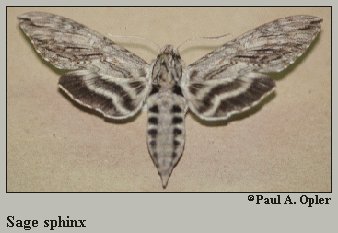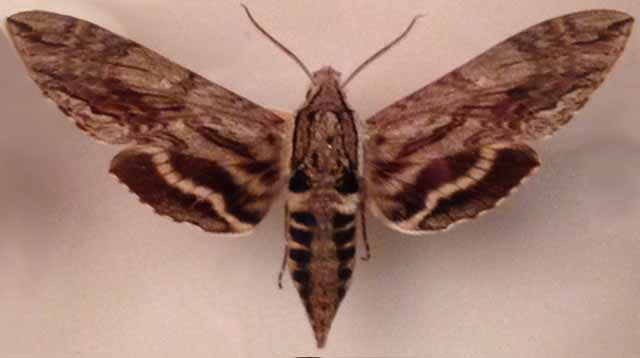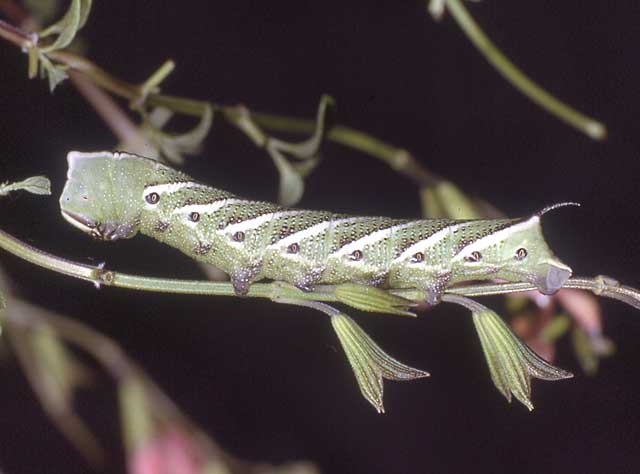|
|
Updated as per The Hawk Moths of the North America, 2007, James P. Tuttle (Sphinx to Lintneria); April 2009
Updated as per CATE; April 2009
Updated as per personal communication with Derek Bridgehouse; February 8, 2016
|
Lintneria eremitoides
(Strecker, 1874) Sphinx
Sage Sphinx Moth

Lintneria eremitoides courtesy of Paul Opler.
This site has been created by Bill Oehlke.
Comments, suggestions and/or additional information are welcomed by Bill.
TAXONOMY:
Family: Sphingidae, Latreille, 1802
Subfamily: Sphinginae, Latreille, 1802
Tribe: Sphingini, Latreille, 1802
Genus: Lintneria Butler, 1876 ...........
Species: eremitoides (Strecker, 1874)
|
DISTRIBUTION:
The seemingly rare Sage Sphinx Moth,
Lintneria eremitoides
(Wing span: 3 - 3 9/16 inches (71-90mm)), flies across sandy
prairies in the Great Plains from Kansas south through central
Oklahoma to Texas, and possibly
west to Colorado and New Mexico, and as a rare stray to western Missouri.
Kansas is the specimen type locality, but the species seems very rare
in that state.

Lintneria eremitoides, Sanderson, Terrel County, Texas,
September 25, 1991, courtesy of Derek Bridgehouse.
The upperside of the forewing is pale gray with a yellowish tint, wavy black lines and dashes, and inconspicuous white
spots. The upperside of the hindwing is pale gray with a white band between two black bands, and a diffuse black patch at the base.
James P. Tuttle in The Hawk Moths of North America, 2007, has resurrected the genus Lintneria originally
designated by Butler, 1876 for eremitus. Tuttle has placed the following North American (U.S.) species in Lintneria: eremitus, eremitoides,
separatus, istar and smithi. In most older texts you will find these five species listed under the genus Sphinx, but larval
morphology and consistent characters of adults indicate Lintneria is appropriate.
Look for this species in Kerr and Uvalde counties in Texas as well as in central Oklahoma (Love County) near Creek banks and edges of
rocky washes where there is sage.

Lintneria eremitoides, 71mm, Ken Osborne, from
Moth Photographers Group
on my home computer only.
"Similar to Lintneria separatus, but readily identifiable by its smaller size
(fwl 32-45 mm. as against 47-55 mm.), pale yellow-grey ground colour and forewing upperside pattern of wavy transverse lines.
Other distinguishing features include:
prothoracic tegulae without obviously yellow marginal spots; mesothoracic tegula with mesial streak much narrower, not
heavier than the distinct black dorsal border; abdomen with lateral marks smaller and more triangular;
foretibia more densely spinose, with 3 or 4 heavy apical spines and a number of smaller ones on the outer surface from apex to
near base; midtibia as long (female) or nearly as long (male) as the first 2 midtarsal segments;
forewing upperside with basal and medio-costal areas more white; apical, oblique, interrupted black streak much thinner;
hindwing upperside with subbasal white band more grey, and the distal border narrower." CATE
FLIGHT TIMES:
Lintneria eremitoides adults fly as
two broods, from April-May and from August-September.
ECLOSION:
Pupae probably wiggle to surface from subterranean chambers just prior to eclosion.
SCENTING AND MATING:
Females call in the males with a pheromone released from a gland at the tip of the
abdomen. Adults nectar at deep-throated flowers.
EGGS, LARVAE, PUPAE:
Larval hosts are Sage (Salvia species).

Lintneria eremitoides, Hwy 83, near Concan, Uvalde County, Texas,
courtesy of James Tuttle.
Please visit my special request for images of Lintneria species larvae at
Lintneria larvae, and help if you can.
It is anticipated that the Lintneria larvae will most often be encountered on Lamiaceae: Salvia (Sage), Mentha (Mints), Monarda (Beebalm) and
Hyptis (Bushmints); Verbenaceae: Verbena and Lantana camara (shrub verbenas or lantanas).
Although they may be encountered feeding during daylight hours, one is even more likely to discover them feeding in the evening or after dark.
Two of the greatest clues for discovering larvae are stripped foliage and droppings beneath the plant. You might be quite surprised at what will turn up in
the evening or after dark in a flashlight assisted search.
It is believed that all "Lintneria larvae will exhibit "a fleshy thoracic dorsal "horn" in the first 4 instars (unique in the Sphingidae of the world to my
knowledge) which is replaced by a thoracic dorsal "hump" with a large black patch in the 5th instar." J.A. Tuttle.
Return to Sphingidae Index
Return to Sphingini Tribe
Use your browser "Back" button to return to the previous page.
This page is brought to you by Bill Oehlke and the
WLSS. Pages are on space rented from Bizland. If you would like to become a "Patron of the Sphingidae Site", contact Bill.
Please send sightings/images to Bill. I will do my best to respond to requests for identification help.
Enjoy one of nature's wonderments: Live Saturniidae (Giant Silkmoth) cocoons.
 | 
Show appreciation for this site by clicking on flashing butterfly to the left.
The link will take you to a page with links to many insect sites. |





